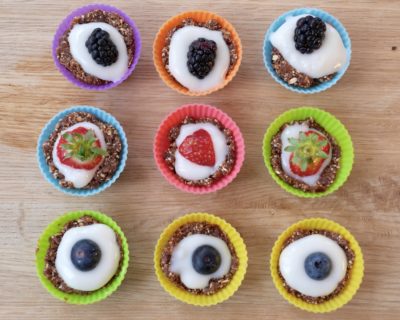How do we encourage children to try more and eat more?
They are famous for the instant reaction: Gross! Yuck! I have even seen some brought to tears upon seeing something that is unusual and being asked to taste it. A child’s reaction to new or different foods is almost always to resist.
One of the programs we teach at Pop, Hop & Rock is Snack & Roll where we move for half the program and make a whole food, raw gluten free, dairy free, nut free snack. To do this we have to use some strange ingredients: avocados to make chocolate pudding or green icing. Dates to make cupcakes, zucchini to make noodles. For some kids (and let’s be honest here: some adults too!) this is entirely too much for the brain to take in not to mention the tastebuds. So we have three rules: #1: we have to taste everything, #2: if we don’t like it we say “no thank you,” and #3: we must clean up. But what we also do is participate in the measuring, spiralizing, squeezing, date pit picking, counting and experimenting with the textures as well as the tastes. This math and science experiment is pretty messy, but almost always successful. Additionally, I have found that 9 times out of 10, even the children who were reduced to tears at the mere thought of having to stick to rule #1, are the ones who are asking for seconds.

What has happened? A couple of things: first, children who participate in making the food that will be eaten are much more likely to taste and ultimately like the food they have made. Of course I wouldn’t suggest pushing the envelope to include they work with anchovies or collard greens! But within reason, it is a great way to get kids to step out of their comfort zone and taste new things.
Second, eating together has always been proven to get kids to eat more. Sitting down as a family and communing over food, gives children the incentive and desire to eat more.
Interestingly, a study just came out that our children will eat more healthy food, particularly fruits and vegetables, if they eat meals with family members (adults) who are projecting positive emotions. These emotions specifically included warmth and encouragement and came from adults who were enjoying themselves at mealtime. Under this scenario, preschoolers actually ate, on average, about one more serving of those good for you foods. This study which came from the University of Illinois and was published in the Journal of Pediatric Psychology, found that the key to getting kids to eat more fruits and vegetables was directly impacted by the emotions and behaviors around the table: the more positive, the more the children chose MORE of the good for you foods.
So for parents looking to get them to eat more of the good stuff the answer is threefold: let them be the co-chef, eat together and bring your best, happiest adult to the table!
Photo by Zahra Amiri on Unsplash

Need a solid resource? Check out our cookbook “If Broccoli Were a Cookie.”
“If Broccoli Were a Cookie” is a collection of recipes pulled from the vault we use every year in our raw, dairy-free, nut-free, gluten-free preschooler cooking class. We love sharing delicious messiness, while sneaking in some counting, tasting, comparing and even some palate expansion. These recipes have been successfully replicated with hundreds of picky preschoolers and incorporates math, language, science, and social studies. For added success, we share our tips and tricks to engage young minds and small hands in the magical art of cooking. Get yours here.
